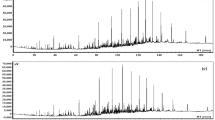Abstract
Investigation of an arson case presents several challenges to the forensic investigator. Identification of the ignitable liquid residues in the fire debris is one of the crucial tasks that may help to determine the nature and cause of fire. Detection of the ignitable liquids using different analytical methods has been practiced for a long period across the globe. Diesel is a petroleum product that shows stable burning than gasoline and it is frequently used as accelerant also. This study was conducted to diagnose the efficiency of solvent as well as of the matrices for the detection of diesel residue. In this study, four different matrices (cotton cloth, wood, glaze tile, and PVC) were selected to create simulated miniature version of arson with diesel as an accelerant. After extinguishing the fire, diesel residues were extracted from the fire debris using hexane and diethylether as extraction solvents under ultrasonication. Gas Chromatography coupled with mass spectrometry was used to identify the major compounds from standard and burnt diesel. Diethylether extracted higher amount of diesel residues from the burnt matrices than hexane. Tile and cotton proved to be the better matrices for the extraction in hexane solvent. However, diethylether present advantageous results and significantly detected the diesel residues in tile, wood and cotton. Findings of this study may help an investigator to select the suitable matrices and solvent for the extraction of diesel residues and may efficaciously contribute in the forensic arson investigation.








Similar content being viewed by others
References
Sturaro A, Vianello A, Denti P, Rella R (2013) Fire debris analysis and scene reconstruction. Sci Justice 53:201–205
Muller D, Levy A, Shelef R (2011) Detection of gasoline on arson suspects’ hands. Forensic Sci Int 206:150
Gorbett GE, Meacham BJ, Wood CB, Dembsey NA (2015) Use of damage in fire investigation: a review of fire patterns analysis, research and future direction. Fire Sci Rev 4:4
Weber BM, Walsh P, Harynuk JJ (2016) Determination of Hydrocarbon group-type of diesel fuels by gas chromatography with vacuum ultraviolet detection. Anal Chem 88:5809–5817
Zhang Y, Zhu X, Zhao C, Peng B, Yang S, Xie L (2019) Study of diesel residues from fire debris in a bus arson experiment. In: Proceedings of 9th international conference on fire science and fire protection engineering vol 2019, ICFSFPE, pp 1–6
Ji B, Liu S, Wang Y (2019) Identification of diesel residues by GC-MS in Fire 2nd on international conference sustainable energy, environment and information engineering (SEEIE 2019). Adv Eng Res 184:2352
Martín-Alberca C, Ortega-Ojeda FE, García-Ruiz C (2016) Analytical tools for the analysis of fire debris. A review: 2008–2015. Analyt Chem Acta 928:1–19
Choi S, Yoh JJ (2017) Fire debris analysis for forensic fire investigation using laser induced breakdown spectroscopy. Spectrochim Acta B Atom Spectrosc 134:75–80
Yadav VK, Harshey A, Das T, Nigam K, Sharma K, Srivastava A (2020) Effect of different matrices on the identification of ignitable liquid residue in post burn arson debris: a multi-derivative UV-visible spectrophotometric approach. Asian J Chem 32(11):2880–2886
Yadav VK, Nigam K, Srivastava A (2020) Forensic investigation of arson residue by infrared and Raman spectroscopy: from conventional to non-destructive Techniques. Med Sci Law 60:1–10
Ferreiro-Gonzalez M, Barbero GF, Palma M et al (2016) Determination of ignitable liquids in fire debris: direct analysis by electronic nose. Sensors 16:695
Stauffer E (2020) Interpol review of fire investigation 2016–2019. Forensic Sci Int: Synergy. https://doi.org/10.1016/j.fsisyn.2020.01.005
Lucas DM (1960) The identification of petroleum products in forensic science by gas chromatography. J Forensic Sci 5:236–247
Bumbrah GS, Sarin RK, Sharma RM (2017) Analysis of petroleum products in fire debris residues by gas chromatography: a literature review. Arab J Forensic Sci 1:560–583
American Society for Testing and Materials (2019) ASTM E1618–19 standard test method for ignitable liquid residues in extracts from fire debris samples by gas chromatography-mass spectrometry. ASTM international, West Conshohocken, PA
Aqel A, Dhabbah AM, Yusuf K, AL-Harbi NM, Al Othman ZA, Badjah-Hadj- Ahmed Y (2016) Determination of gasoline and diesel residues on wool, silk, polyester and cotton materials by SPME-GC-MS. J Anal Chem 71:7
Stauffer E, Dolan JA, Newman R (2008) Fire debris analysis. Academic Press
Prather KR, McGuffin VL, Smith RW (2012) Effect of evaporation and matrix interferences on the association of simulated ignitable liquid residues to the corresponding liquid standard. Forensic Sci Int 222:242–251
American Society for Testing and Materials (2015) ASTM E1386–15, standard practice for separation of ignitable liquid residues from fire debris samples by solvent extraction. ASTM International, West Conshohocken, PA
Author information
Authors and Affiliations
Corresponding author
Additional information
Publisher's Note
Springer Nature remains neutral with regard to jurisdictional claims in published maps and institutional affiliations.
Rights and permissions
About this article
Cite this article
Yadav, V.K., Das, T., Harshey, A. et al. A Forensic Approach to Evaluate the Effect of Different Matrices and Extraction Solvents for the Identification of Diesel Residue in Simulated Arson by GC–MS. Chromatographia 84, 413–423 (2021). https://doi.org/10.1007/s10337-021-04022-1
Received:
Revised:
Accepted:
Published:
Issue Date:
DOI: https://doi.org/10.1007/s10337-021-04022-1




